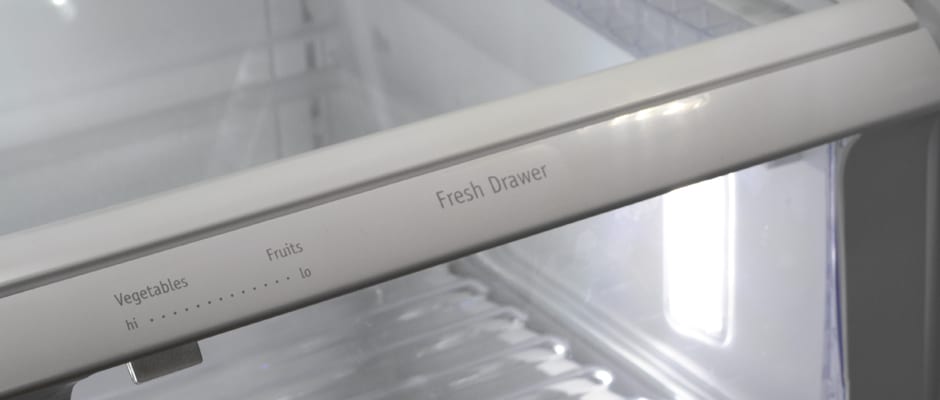Introduction
Design & Usability
Not fancy, but with some user-friendly touches.
Anyone who has looked inside a French door refrigerator over the past 10 years or so won't be surprised by the Frigidaire Gallery's overall design. Glass shelves surrounded by thick white plastic isn't as au courant as thinner stainless trim shelves, and where most manufacturers seem to be moving to on-the-door ice makers, Frigidaire continues to leave it on the top shelf of the freezer. The control panel is no better. It has a lot of options, but it presents them in teeny-tiny fonts that are almost too small to read. Also, its touchscreen appearance is misleading: comprised of multifunction buttons set into a black surface, it's pretty cumbersome to navigate—think programming your VCR in the late 1980's and you'll get the picture.
Despite the simple aesthetic choices here, there are actually some very nice subtleties to the design which could make life easier for consumers. For instance, all of the adjustable shelves slide forward, granting easy access to items stuck in the back. They also make it possible to clean spills without having to take a shelf entirely out of the fridge. In addition, a retractable shelf simplifies tall item storage, and an abundance of half shelves improves customizability.
Nevertheless, the overall feel is decidedly midrange. Plastic drawers on plastic runners are hard to open and are ever-so-slightly crooked. We noticed a similar issue with the freezer, where the pull-out shelf came out at a slightly skewed angle. It doesn't impact storage capacity or any functional element of the fridge, but the interior is outclassed by competitors that cost only a slight bit more. Frigidaire's finish may make the fridge look a bit darker, but it is unusually resistant to smearing and fingerprints—great for families with small children!—plus, since it's 430 grade stainless, you can use magnets. On the other hand, it may not match the rest of your kitchen.
{{photo_gallery "Front", "Water Ice Dispenser Controls", "Water Ice Dispenser", "Controls", "Handles", "Interior", "Fridge", "Ice Maker", "Water Filter", "Crisper Drawer", "Freezer", "Side", "Back"}}
Performance & Features
Good temperature consistency despite a few other flaws.
This Frigidaire falls prey to an all-too-common problem: the temperature reading on the control panel doesn't match the temperature inside the fridge. In this case, it's particularly frustrating because this Frigidaire's temperature output over time is actually quite consistent. Unfortunately, both fridge and freezer ran a bit warmer than the big 37 and zero we saw displayed on the control panel. If you choose to buy this product, you'll need to calibrate it on your own, or risk subpar food preservation.
Sadly, the crisper drawers just aren't very good, and lose more moisture than average. That means you may notice your produce spoiling a bit faster than expected. Otherwise, there's not really anything special that sets this fridge apart. You've got a basic ice maker, as well as a through-the-door water and ice dispenser, but that's it. At $2,500, it seems fair to expect some innovation, but this Frigidaire doesn't really supply anything in that regard.
The Cold Truth
Cooling hearts and minds, not food.
The Frigidaire Gallery FGHB2866PF is an entry-level high-end fridge. That may sound like an oxymoron, but it's relatively inexpensive for a 27.8 cubic foot French door with a stainless exterior and through-the-door ice and water... as long as you find it on sale. Performance-wise, we had few complaints, and our biggest one—calibration—is easy to correct if you've got a thermometer. Unless you'd rather save your pennies for a sleeker French door or downsize to something more affordable, this Frigidaire hits a sweet spot for customers who need lots of capacity for the least amount of money. That said, just make sure you don't pay the exorbitant $2,500 MSRP.
Update (5/17/13):** An earlier version of this article referred to this fridge's exterior as "stainless-look," when in fact it is finished with 430-grade stainless, which is magnetic. A representative from Frigidaire informed us that this Gallery also features a fingerprint-resistant coating applied over the steel, likely the cause of the darker-than-average look.
Introduction
If you pay extra for a high quality product, you generally expect high quality results. Unfortunately, the tests that were run on the Frigidaire Gallery FGHB2866PF produced results which don't quite match the price tag. Calibration issues—a correctible failing—soured our experience with this overpriced product, and other tests didn't exactly impress. If you're mainly concerned about consistency, though, this fridge actually turned out to be pretty decent.
Temperature Performance
Consistency doesn't always belie innate accuracy.
With temperature variations averaging just one third of a degree over time, this Frigidaire is actually very consistent. That means food isn't being exposed to shifts in temperature, a major factor in rapid spoiling. The issue we have here is more so with calibration. We set the control panel to 37 degrees Fahrenheit; unfortunately, the internal temperature of our test material only averaged 40.32 degrees. What's worse is that the average temperature at the top clocked in at 40.63, cooled to 39.04 in the middle, and then warmed back up to 41.28 near the bottom. That's a full-range spectrum of almost two and a half degrees, an indicator of poor air circulation. If you remember to double check the temperature when you initially install the fridge, however, and don't shift things around from one shelf to another, you can accomodate for both of those issues.
The freezer was a little worse. Despite the fact that we set the thermostat to an even zero degrees, we found that the average temperature in the upper portion of the compartment was about 2.33 degrees, while the bottom came in at a cooler 1.33. Keep in mind that the freezer is not very tall: that's a shift of one full degree over a span of about 20 inches from top to bottom. We also observed degree shifts that ranged from 0.7 to 0.9 degrees over time, squeaking rather close to the edge of the acceptable range. Any wider and your food would be at a slightly higher risk of developing freezer burn.
{{photo_gallery "Fridge Temperature", "Fridge Temp Graph", "Freezer Temperature"}}
Moisture Retention
It's not getting any better, folks.
The crisper drawers definitely wilted under the glare of our moisture retention test results. Over the course of three days, our test material lost an average of 0.21 grams of water per hour. Admittedly, it's not the worst we've seen... but that's not exactly a compliment. It's slightly worse than average, bad enough that fresh fruits and vegetables stored here will likely spoil faster than they would in drawers with a better design. Given the sticky opening and closing issues, as well as the crookedness of the shelves and drawers themselves, we'd be lying if we said we were surprised.
Freezing & Thawing
Some cold comfort.
Well, the Frigidaire didn't fail the freezing test, but it didn't exactly pass with flying colors. Room temperature test material took one hour and 42 minutes to reach a frozen state. That's not inconsistent with a majority of fridges this size—many high-end products produce similar time spans—but we'd prefer to see something a bit faster. This is slow enough that you run the risk of encountering reduced texture quality in meat and fish, as well as other sensitive food items, after you thaw them.
Ending on a high note, our friendly Frigidaire did manage to pass the thawing exam. After unplugging it for 36 hours, the internal temperature of our frozen test items had only reached 27.45 degrees Fahrenheit. That's thoroughly frozen, and as long as you don't open and the close the freezer during a power outage, this product should preserve your food as long as you have a reasonably responsible electricity provider.
{{photo_gallery "Freezing Graph", "Power Loss Graph"}}
Storage Space & Energy Efficiency
We've seen bigger.
The usable amount of storage space in the Frigidaire is pretty good, but with the large internal ice maker taking up a hefty amount of room, you're already starting with a substantial deficit. In the main storage cavity, you've got six shelves—four of which are adjustable, including the thin shelf we kept next to the ice maker and the one with the retractable front—two crisper drawers, and a full-width drawer on the bottom. Throw in the six door shelves—several of which have to curve around the ice dispenser—and one dairy bin, and you've got yourself a respectable 11.57 cubic feet of storage space to work with.
In terms of frozen storage, you've got a small number of wide open spaces. Depending on your shopping habits and how much you like to keep in the freezer at any given time, this could be a good or a bad thing. Either way, you'll have four sections to take advantage off: both the upper and lower drawers are split into two sections each by an adjustable divider. In total, they provide a maximum of 5.14 usable cubic feet.
At the very least, we can happily report that this is a fairly energy efficient product. We use a standard rate of $0.09 kWh to calculate our power costs, and as such, determined that this Frigidaire will only run you $50.30 per year to operate. It's slightly cheaper than average for a fridge this size, and keep in mind that we got that figure with the ice maker in operation. Spreading out all that energy over the available storage reveals that each cubic foot of available storage only requires 0.09 kWh. For all of its other failings, this is definitely a fridge that will keep your long-term electric bill fairly low. Keep in mind, though, that decreasing the temperature on the control panel to make up for the aforementioned calibration issues may cause your fridge to work just a hair harder.
{{photo_gallery "Fridge Storage", "Left Door Storage", "Right Door Storage", "Freezer Storage", "Power Data"}}
Meet the tester
Matthew is a native of Brockton, MA and a graduate of Northeastern, where he earned a degree in English and Theatre. He has also studied at the Gaiety School of Acting in Dublin and spends most of his free time pursuing a performance career in the greater Boston area.
Checking our work.
Our team is here to help you buy the best stuff and love what you own. Our writers, editors, and experts obsess over the products we cover to make sure you're confident and satisfied. Have a different opinion about something we recommend? Email us and we'll compare notes.
Shoot us an email

